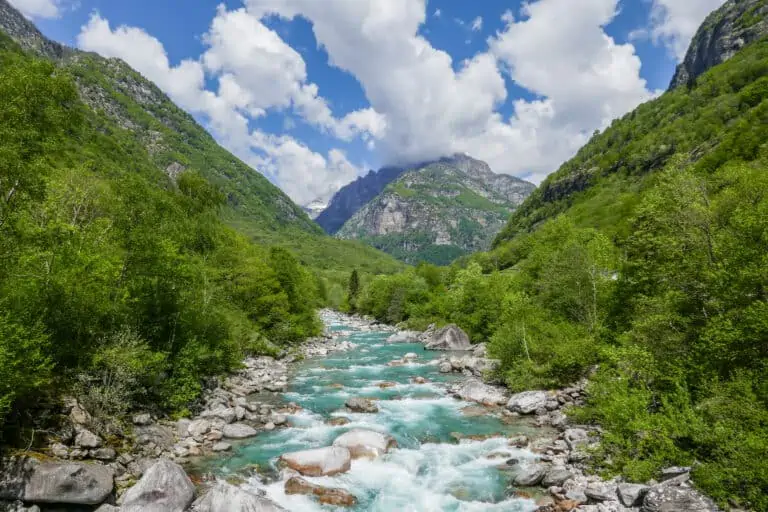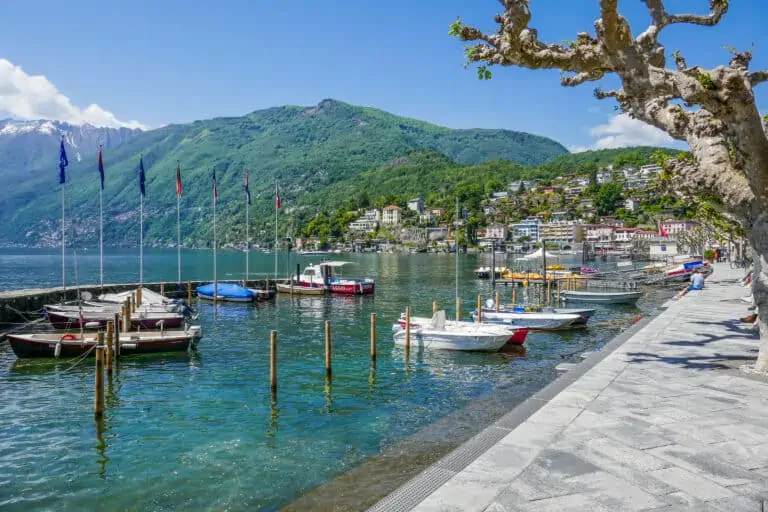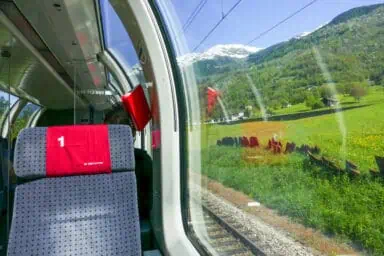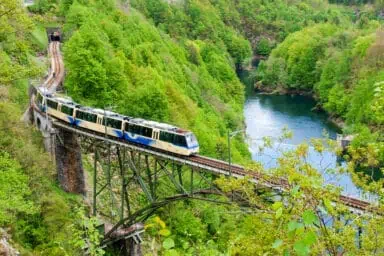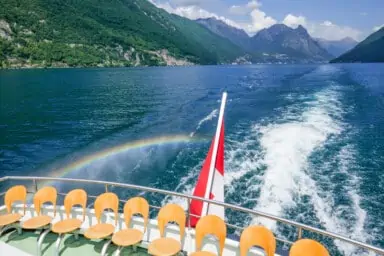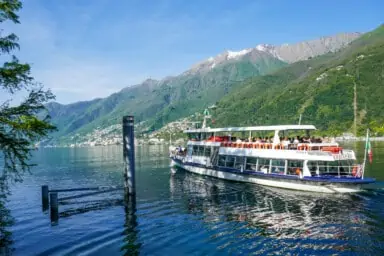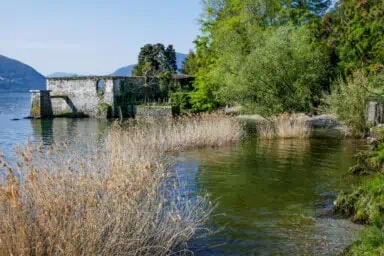Activities in the Ticino 
What not to miss in the Ticino
If you can't spend much time in Ticino, we recommend to at least do one of the below activities:
- If your itinerary allows it, it's great to apart or arrive by a panoramic train. Have a look at what the Bernina Express (Chur-Tirano-Lugano), Centovalli Railway (Domodossola-Locarno), and Gotthard Panorama Express (Lucerne-Bellinzona-Lugano) have to offer.
- Enjoy the scenery during a boat ride on Lake Lugano or Lake Maggiore.
- Try to include at least one of the vantage points in the mountains of the Leventina, Lake Maggiore, or Lake Lugano.
- Explore one of the lakeside towns. We've created easy walks in Locarno, Ascona and Lugano to see all highlights.
Our one-day trip in the Ticino
If you can spend just one day in the Ticino, our proposed one-day round trip can help you see the highlights.
Mountains in the Ticino
These are the main mountain excursions you can enjoy in northern Ticino:
- The cable car from Airolo to Pesciüm in the Gotthard Mountains, operational in both summer and winter. It's an excellent starting point for hikes and mountain bike rides. You can continue your journey even higher up to Sasso della Boggia at over 2000 m. A special attraction here is the panoramic swing.
- The steep funicular from Piotta to Piora, where you can start hiking or mountain biking. It operates in summer only.
- The cable car from Rodi-Fiesso to the mountain lake of Tremorgio, accessible from June to October.
- The summer chair lift from the small village of Carì to viewpoint Brussada.
In the Lake Maggiore region, the funiculars to Madonna del Sasso and the cableways to Cardada-Cimetta are the main mountain rides.
The Lugano region is full of mountains with panoramic views. Find our recommendations in our Lake Lugano activity overview.
Hiking suggestions in the Ticino
In the northern Ticino and in the Lake Maggiore area, these are the hikes we particularly recommend:
- The roundabout walk to and from Monte Carasso, including the Carasc suspension bridge.
- The easy stroll from Faido to the Piumogna waterfalls.
- The 3-castle route in Bellinzona.
- The easy lakeside stroll from Tenero to Locarno.
- A hike from the town of Brissago to the Sacro Monte church up in the valley.
- The hike from Lavertezzo to Ganne in the Valle Verzasca (Verzasca Valley). Lavertezzo has become very popular in the past years, due to social media exposure of the stone Ponte dei Salti bridge spanning the Verzasca river. It's indeed a beautiful location, but if you prefer to beat the crowds on good-weather days in summer, we advise you to start your hike early.
- Trails in the Valle Maggia.
In the Lake Lugano region, we think Lugano-Gandria is a must.
The best places to see
The Ticino is full of authentic villages worth a visit. Our top picks:
- Giurnico in the Leventina, home to the Leventina Museum
- Ascona on Lake Maggiore
- Brissago on Lake Maggiore
- Lavertezzo in the Verzasca Valley
- Sonogno and the La Froda waterfall in the Verzasca Valley
- Gandria on Lake Lugano
- Morcote on Lake Lugano
Day excursions to Italy
It's possible to visit the Lake Como area, or make other day trips into northern Italy, if you're based near Locarno or Lugano. Find suggestions in our travel guide Italy-Switzerland.
Essential travel info and map 
How to reach the Ticino from Central Switzerland
From Central Switzerland, including Lucerne, the most scenic way to reach the Ticino is the Gotthard Panorama Express to Bellinzona and Lugano.
If you prefer the quickest route from Zurich or Lucerne to the Ticino, take any of the direct trains as suggested by the timetable. Those trains cross the 57 km long Gotthard Base Tunnel which is not scenic but certainly quick!
A trip by car from Central Switzerland takes longer. You can drive either via the 17 km long Gotthard tunnel (open year-round), or via the Gotthard Pass at an altitude of 2,094 m (only open in summer). This route is known for traffic jams, with waiting times up to 4 hours. For convenience, scenery, and travel time, the trains are recommended.
How to reach the Ticino from Italy
From the south, for example from Milan, there are excellent roads and trains to Chiasso at the Swiss-Italian border and to Lugano. Learn all about the options in our Italy to Switzerland travel guide.
How to travel to the Ticino from the Valais
From the canton of Valais, you can reach Domodossola in Italy. In Domodossola, continue on the scenic Centovalli Railway to Locarno in the Lake Maggiore region.
Another option by road is the Nufenen Pass (2480 m, only open in summer).
How to enter the Ticino from Graubünden
From the canton of Graubünden, the best way to the Ticino is the Bernina Express: a scenic train and bus route between Chur/St. Moritz, Tirano (Italy) and Lugano.
Apart from that, there is a road via the San Bernardino Pass (altitude 1,630 m), which is open year-round and offers bus services too. The pass includes a 6.5 km long tunnel which can be bypassed via the old pass route, but only in summer.
How to travel within the Ticino
Public transport is excellent and can take you almost anywhere. Trains operate frequently. The major towns Bellinzona, Lugano and Locarno are only 35 minutes or less apart.
There's public transport to viewing points on the peaks and within cities. Bus services to remote valleys and some boats may operate hourly or even less frequent, so in those cases it is useful to check the schedules in advance.
As in all of Switzerland, many places with the exception of the peaks can be reached by car as well. The center of larger towns like Lugano can best be avoided with a car. One-way streets, pedestrian zones and expensive parking are common. All towns can easily be reached by train and explored on foot or by public transport.
Learn more about car versus train traveling in Switzerland here.
Rail passes: the Ticino Ticket and other options
If you spend one or more nights in a hotel, hostel or on a campsite in the Ticino, you'll receive the free Ticino Ticket. It offers free traveling on many routes throughout the canton, and discounts on mountain routes and other activities. The Ticino Ticket is not available for visitors staying in holiday rentals.
Alternatively, have a look at rail passes that are valid in all of Switzerland. They provide perfect coverage for the Ticino too.
If you want to figure out which pass suits your plans best, our comparison guide may help you out.
Ticino in Switzerland on a map
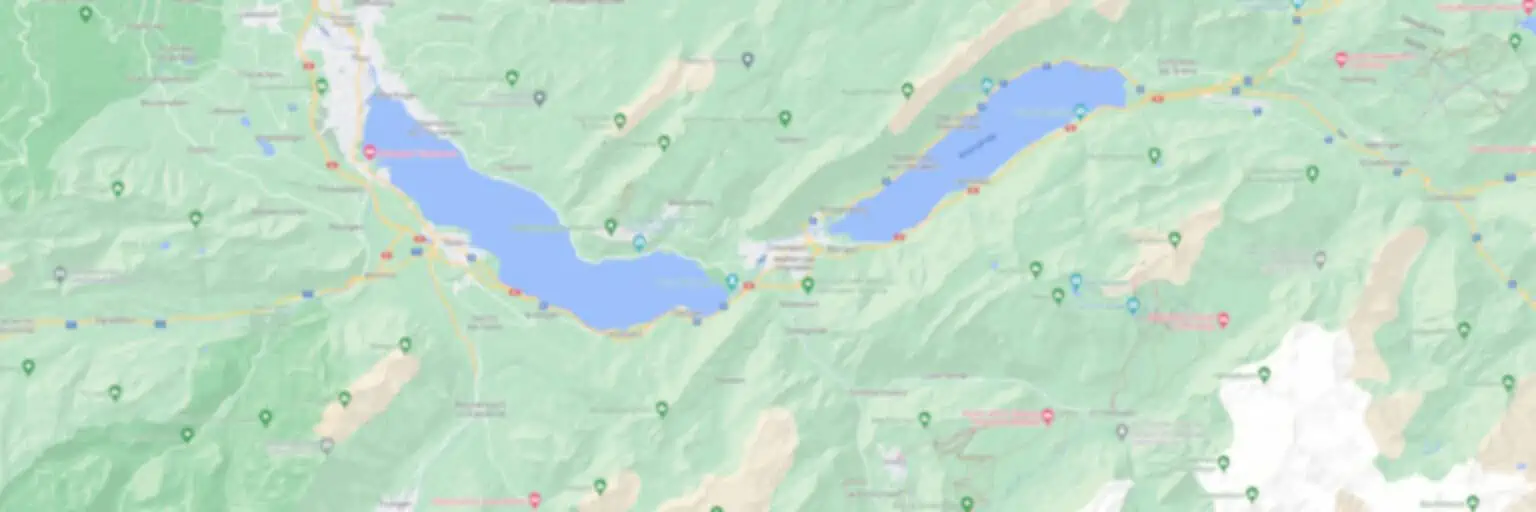
The best time for a stay in the Ticino 
Ticino in spring, summer and fall
We advise visiting the Ticino in late March to late October. These months do must justice to the attractive green scenery of the canton.
Our personal preferences within this timeframe are April-May and October. Even though these are considered to be low-season months in many other Swiss regions, they're actually perfect for the Ticino. As most of it is at low elevations, you can make plenty of hikes: it's not likely that trails are covered by snow.
We also prefer the more moderate temperatures of spring and fall. But that's personal. The region is very attractive in summer too. So if you like some Mediterranean warmth, by all means enjoy the Ticino in June, July, August or September!
Ticino in winter
We wouldn't recommend the Ticino as a winter destination. To us, the green hills and valleys are what makes the Ticino attractive. From November to mid-March, the scenery lacks the appeal it has during the rest of the year.
With the exception of the mountains around the Gotthard Pass and in the Leventina Valley, there aren't many ski areas in the Ticino.
Weather in the Ticino 
What the Ticino climate is like
Most of the Ticino is at low elevation, and there are no mountains high enough to block the warm Mediterranean air from the south. This means that temperatures are mild to warm, and that the Ticino is a sunny corner of Switzerland.
Which temperatures to expect
Temperatures vary by altitude, and by whether or not a town is in the mountains in the north of the canton. Examples:
- Airolo, which is in the Gotthard Mountains at 1141 m, has average daytime temperatures of 18-22°C in summer, and in 1-7°C winter.
- Locarno, very to low Swiss standards at just 200 m, is significantly warmer: daytime temperatures range from 24°C to 28°C in summer, and from 8°C to 12°C in winter. Comparable average temperatures go for Bellinzona and Lugano.
Rain and snow in the Ticino
Rainfall can occur in each season in the Ticino. On average, the area is drier than many regions in northern Switzerland though, such as the Lake Lucerne area or the Bernese Oberland.
There are significant regional differences within the canton. Mountain resorts in the northern Gotthard mountains, such as Airolo, are wetter than the lower towns in southern Ticino.
The same goes for snowfall. Snow is reasonably likely to occur in the north of the Leventina Valley during the winter months (especially January and February), but way less probable in Bellinzona, Locarno and Lugano.
5-day weather forecast for the Ticino
Below is a sample 5-day weather forecast for Gerra, a village roughly in the middle of the Ticino. Always consult local, short term weather forecasts for your specific destination.

Accommodation in the Ticino 
There are excellent hotels in the Ticino. The larger towns of Locarno and Lugano offer the widest range of options: from budget to luxury. Top-class hotels with panoramic views are even widely available in Lugano.
Holiday rentals and campsites are an option too. Note that you're not entitled to a Ticino Ticket if you stay in a holiday home or apartment.
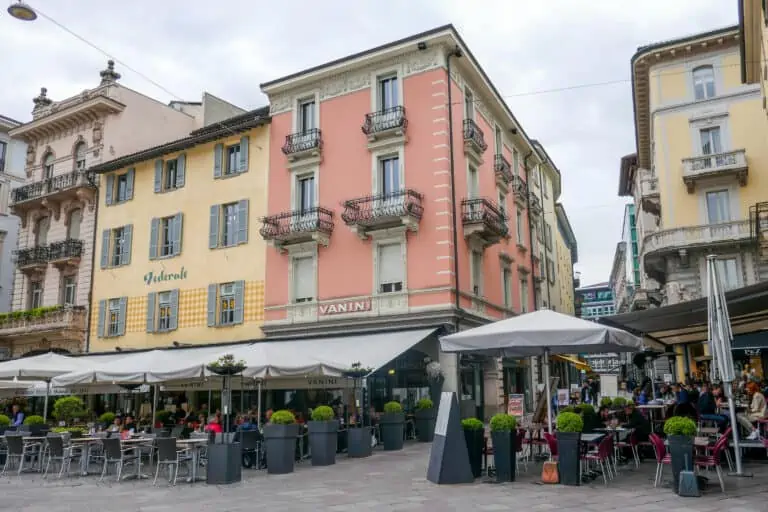
Hotels in Lugano, Switzerland
Is the Ticino worth visiting?
After our holidays here, our answer is yes! We recommend the Ticino for the following reasons:
- The canton adds a lot of variety to other Swiss regions. Its Italian food, sunny climate, and Mediterranean atmosphere are unique to this part of Switzerland.
- The scenery is simply beautiful. We ourselves love fresh green nature, moderate temperatures and snow-capped mountains: the type of scenery that can mostly be found in northern Switzerland. But the landscape of the Ticino pleasantly surprised us. The large lakes, pretty lakeside towns with boulevards, rolling green hills and remote valleys are very attractive.
- The larger towns of Locarno and Lugano offer plenty of outdoor and indoor activities year-long.
- The Ticino can perfectly be combined with an entry from, or an exit to, Italy.
What Ticino is like
Switzerland is a country with a huge variety of different landscapes and climates. This applies to the large canton of Ticino too.
In the north: the high mountains of the Leventina
The main mountain range of the Alps marks the northern border of the Ticino, with the village of Airolo in the Leventina Valley (Val Leventina) at 1,141 m as the starting point of the famous Gotthard Pass. This pass can be crossed by the Gotthard Panorama Express. The peaks are over 3,000 m high here.
You’ll find hundreds of kilometers of hiking trails in the Leventina Valley and the Blenio Valley east of it. In addition, there are several mountain tops to be visited by cable car and funicular.
Half-way: Biasca, Riviera and Bellinzona
South of the Leventina Valley, and located at much lower elevation, is the area of Biasca, Riviera and Bellinzona. Bellinzona is the best-known town here. It’s primarily famous for its three medieval castles.
In the south: Switzerland’s lowest point and large lakes
Further south, there’s the lowest point of the entire country: Lake Maggiore, just below 200 m. The northern part of this lake is located in Switzerland, the southern part in Italy. This area has a Mediterranean climate with palm trees, flowers, and green mountains up to 2,000-2,500 m. Locarno is the main town here: an attractive and centrally located lakeside place.
Ascona on Lake Maggiore is worth mentioning too. This atmospheric little town with its colorful boulevard is very attractive. It doesn’t have a railway station though, so if you travel by public transportation you’ll have to get to Locarno by bus first, and catch a train there.
South-east of Locarno is Lugano, located on the large Lake Lugano and surrounded by green mountains. Lake Lugano too is partially in Switzerland and partially in Italy. We share all of our tips about this region in our Lake Lugano guide.
Where to stay in the Ticino
In our opinion, the below towns of the Ticino are worth your consideration:
- Bellinzona is a good option if you like to be located centrally. You can quickly reach Arth-Goldau and even Lucerne on the northern side of the mountains. Locarno and Lugano are under 30 minutes by train away. Bellinzona is a good choice too if you love cultural heritage: it’s famous for its three castles.
- Lugano is the place to be if you appreciate a mid-size lakeside city, with a bustling town center. You can find quite some luxurious hotels with panoramic views here. The hills and the lake make for wonderful scenery.
- Locarno is perfect if you like to be located on Lake Maggiore and prefer to have lots of facilities.
- Ascona near Locarno is recommended if you prefer a small and vibrant village, and if you don’t mind the absence of a rail station. You can easily travel by bus though.
- Brissago is another town on Lake Maggiore. It’s further south of Locarno and less touristy than Ascona. It’s also close to the Italian border. Again, there’s no rail station, but there are frequent buses.
Other websites of interest
- www.bellinzonaevalli.ch: Leventina, Blenio and Bellinzona Tourism
- www.ticino.ch: Ticino Ticket
More about the main towns of the Ticino 
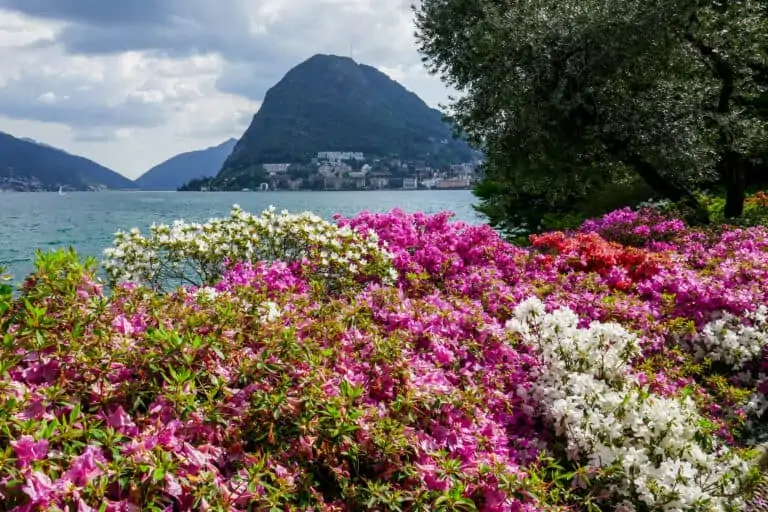
Lugano
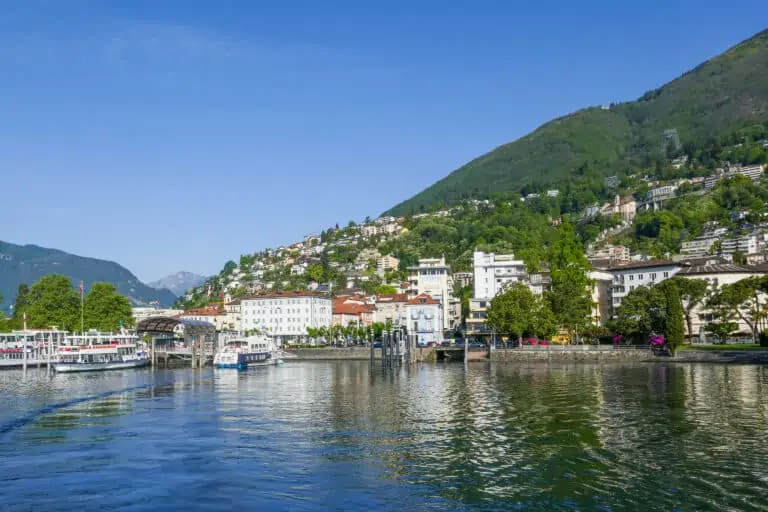
Locarno
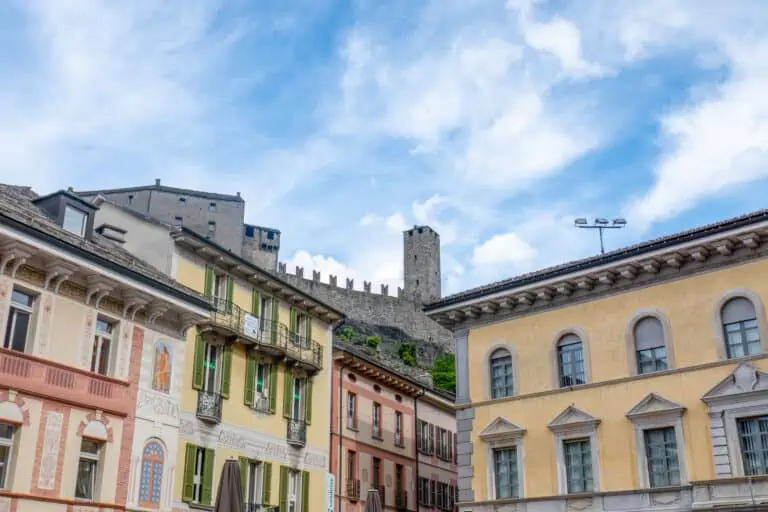
Bellinzona
Itineraries including the Ticino 
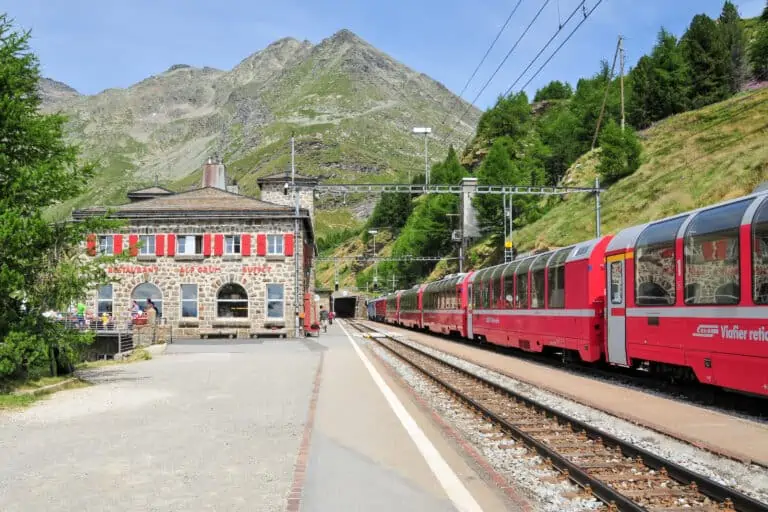
Ultimate scenic trains
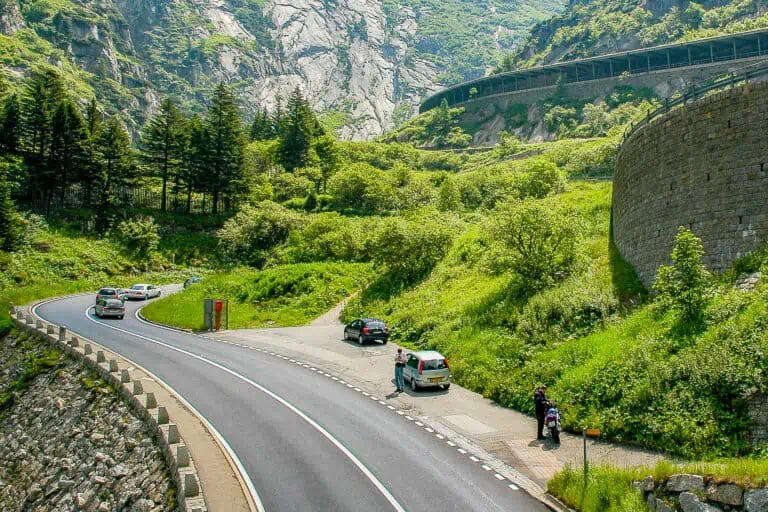
Pass road tour
The Ticino in our blog posts 
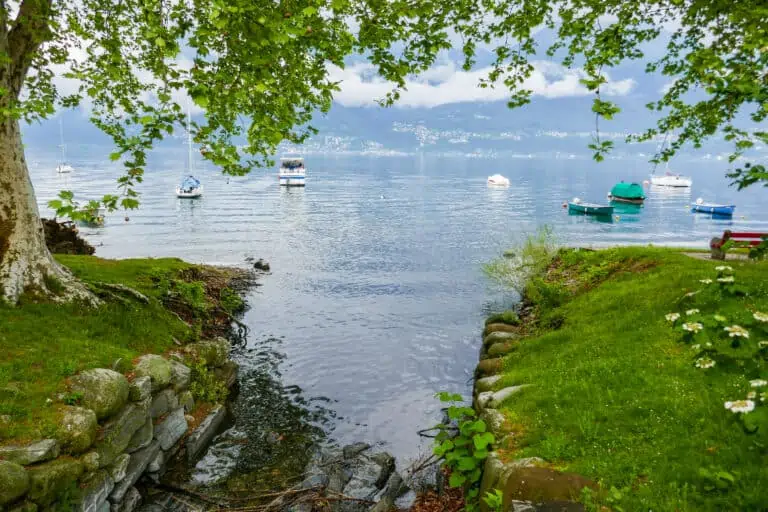
Hike Tenero-Locarno
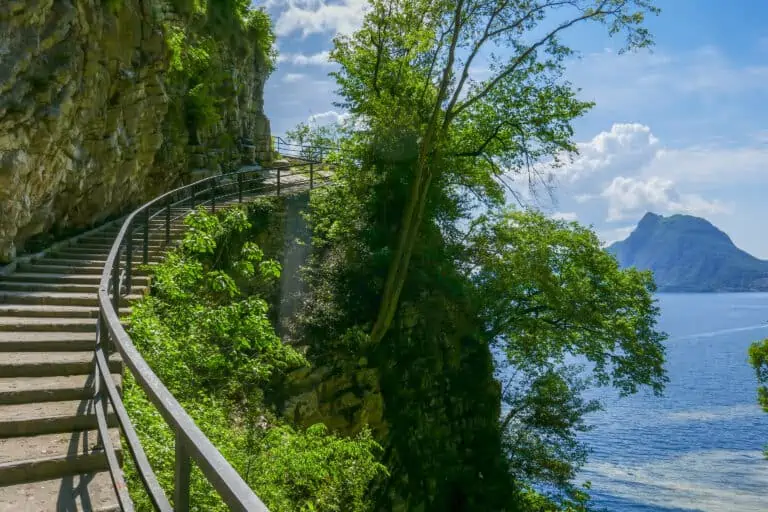
Hike Lugano-Gandria
